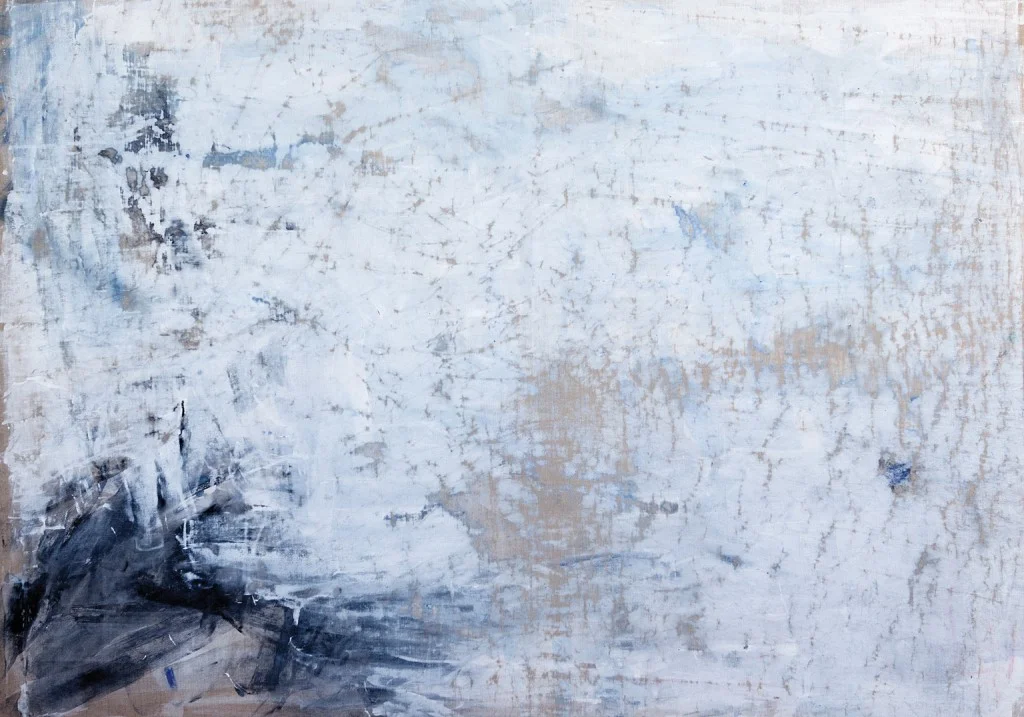art
Cole Sternberg Goes Under The Sea To Find His Art
The L.A.-based artist spends 22 days aboard a bulk-shipping vessel and creates 18 salt-water-infused paintings.
Who can guess the secret of the sea? Woody Guthrie intoned in his unrecorded verse written during the years he lived on Mermaid Avenue in Coney Island. That the sea is enigmatic is something practically innate in humanity, but to that point, it’s believed we almost know more about the farthest reaches of the universe than we do about the deepest parts of our oceans— a mere 36,000 feet below the surface.
[](http://images.squarespace-cdn.com/content/v1/56c346b607eaa09d9189a870/1487292953510-BX8IK8KNP8D1DMPFQCX2/MAMA_Cole-Sternberg_patternscanbedeceivingevenifconsistent.jpg)
Cole Sternberg—the Los Angeles-based visual artist, former law student, and poet—is a man with a few secrets. In late 2015, Sternberg boarded the bulk-shipping vessel Ultra Letizia in Shin Kasado, Japan, and got off in Portland, Oregon 22 days later. Sternberg worked outdoors most days making 18 paintings, each created by painting on linen and then dragging the pieces through the water. “I started with a general concept that I wanted to expose them to the environment,” Sternberg says, “I had four paintings outside, \[when we were caught in a storm\] and I’d thought I’d lost them. They got really wet and fell off the walls, but ended up hugging parts of the ship and they weren’t lost.”
Those pieces gave Sternberg the idea to submerge the remaining paintings. Some were dragged through the sea for ten hours, others for only five minutes, but all of the works in the series have had some kind of direct contact with the ocean.
In addition to the paintings, Sternberg brought a small crew to record the experience for a future documentary: a cinematographer, a sound artist— who collected the sounds from the ship for the soundtrack—and a writer who wrote long-form editorials and conducted interviews along the way. The entirety of the series was shown at MAMA Gallery in Downtown Los Angeles as the exhibition _The Nature of Breathing in Salt_, exploring themes of trade, commerce, and the environment— and followed through on questions that were raised with his 2014 series Trade Theories of an Obsessive State, in which Sternberg commissioned Chinese artists to reproduce the ceiling of the Sistine Chapel inside a shipping container, after which he traveled with that container from Hong Kong to Miami.
In asking Sternberg if he discovered any secrets out there on the open sea he replies, “I learned some secrets, but they all kind of don’t feel like secrets, they feel like obvious things: certain seafaring people do it solely for the money and for their families; certain ones like going to ports where there’re prostitutes and beaches, other ones don’t care and just want to read a book.
The only secrets are the ones found out later through individuals. Everything kind of felt honest. The secrets that were hidden under the water are still hidden.”
[](http://images.squarespace-cdn.com/content/v1/56c346b607eaa09d9189a870/1487293020516-K1L3CTQWTYVEECEKTFE2/Screen-Shot-2016-03-31-at-13.50.19.png.19.png?format=original)
The L.A.-based artist spends 22 days aboard a bulk-shipping vessel and creates 18 salt-water-infused paintings.
Who can guess the secret of the sea? Woody Guthrie intoned in his unrecorded verse written during the years he lived on Mermaid Avenue in Coney Island. That the sea is enigmatic is something practically innate in humanity, but to that point, it’s believed we almost know more about the farthest reaches of the universe than we do about the deepest parts of our oceans— a mere 36,000 feet below the surface.
[](http://images.squarespace-cdn.com/content/v1/56c346b607eaa09d9189a870/1487292953510-BX8IK8KNP8D1DMPFQCX2/MAMA_Cole-Sternberg_patternscanbedeceivingevenifconsistent.jpg)
Cole Sternberg—the Los Angeles-based visual artist, former law student, and poet—is a man with a few secrets. In late 2015, Sternberg boarded the bulk-shipping vessel Ultra Letizia in Shin Kasado, Japan, and got off in Portland, Oregon 22 days later. Sternberg worked outdoors most days making 18 paintings, each created by painting on linen and then dragging the pieces through the water. “I started with a general concept that I wanted to expose them to the environment,” Sternberg says, “I had four paintings outside, \[when we were caught in a storm\] and I’d thought I’d lost them. They got really wet and fell off the walls, but ended up hugging parts of the ship and they weren’t lost.”
Those pieces gave Sternberg the idea to submerge the remaining paintings. Some were dragged through the sea for ten hours, others for only five minutes, but all of the works in the series have had some kind of direct contact with the ocean.
In addition to the paintings, Sternberg brought a small crew to record the experience for a future documentary: a cinematographer, a sound artist— who collected the sounds from the ship for the soundtrack—and a writer who wrote long-form editorials and conducted interviews along the way. The entirety of the series was shown at MAMA Gallery in Downtown Los Angeles as the exhibition _The Nature of Breathing in Salt_, exploring themes of trade, commerce, and the environment— and followed through on questions that were raised with his 2014 series Trade Theories of an Obsessive State, in which Sternberg commissioned Chinese artists to reproduce the ceiling of the Sistine Chapel inside a shipping container, after which he traveled with that container from Hong Kong to Miami.
In asking Sternberg if he discovered any secrets out there on the open sea he replies, “I learned some secrets, but they all kind of don’t feel like secrets, they feel like obvious things: certain seafaring people do it solely for the money and for their families; certain ones like going to ports where there’re prostitutes and beaches, other ones don’t care and just want to read a book.
The only secrets are the ones found out later through individuals. Everything kind of felt honest. The secrets that were hidden under the water are still hidden.”
[](http://images.squarespace-cdn.com/content/v1/56c346b607eaa09d9189a870/1487293020516-K1L3CTQWTYVEECEKTFE2/Screen-Shot-2016-03-31-at-13.50.19.png.19.png?format=original)
